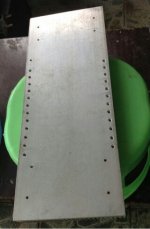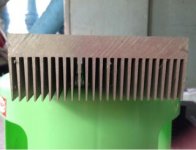Hi Hugh,
I hope you are keeping well and enjoying your routine.
For the big boy, would you recommend to include
1. gnd lift with 10R+anti|| diodes
2. on board zobel
3. small decoupling electro caps near each mosfet (may not be an issue here, more for high power class -AB in my understanding)
4. diodes for reactive speakers (as suggested by you earlier, these may be only for high power amps, but would like to gather your teachings in this particular case)
5. on-board fuses
6. build recommendations like the speaker terminal as in here (universal thiele circuit).
I would love to have this amp driving my planned speakers and want it to be safe for any kind of build situation as we are seeing a variety and unique kind of builds here.
Heatsinking would present a lot of problems for me, cant go for liquid cooled.. Is there any way to make it with fan cooled?
regards
Prasi
I hope you are keeping well and enjoying your routine.
For the big boy, would you recommend to include
1. gnd lift with 10R+anti|| diodes
2. on board zobel
3. small decoupling electro caps near each mosfet (may not be an issue here, more for high power class -AB in my understanding)
4. diodes for reactive speakers (as suggested by you earlier, these may be only for high power amps, but would like to gather your teachings in this particular case)
5. on-board fuses
6. build recommendations like the speaker terminal as in here (universal thiele circuit).
I would love to have this amp driving my planned speakers and want it to be safe for any kind of build situation as we are seeing a variety and unique kind of builds here.
Heatsinking would present a lot of problems for me, cant go for liquid cooled.. Is there any way to make it with fan cooled?
regards
Prasi
That pre-empts 480W devices, or even 1040W versions from IXYS.
Hi Hugh,
What is the part number for that IXYS 480W and 1040W respectively?
Thanks!
Do
Hi Hugh,
What is the part number for that IXYS 480W and 1040W respectively?
Thanks!
Do
I think it is FDA69N25 for N channel
FDA69N25 ON Semiconductor / Fairchild | Mouser
and IXTH48P20P for P channel:
IXTH48P20P IXYS | Mouser
At least that is what I am ordering for the ALPHA 52 BB.
Hi Prasi,
Thank you for your inquiry about my health, you really should not ask elderly gentlemen this, they might tell you and you might find they speak for an hour.......
#1 is a very good idea. X found it worked well with the 20W ALPHA so I will add it to the schematic and beg JPS to insert it into his pcb!
#2 No Zobel on the output is because it uses only 21dB of global feedback and together with Class A operation it not needed.
#3 could be a zobel (snubber) on the gate to drain, and this too with large mosfets it should be done. 220pF and 47R is the ticket. Good idea, thanks.
#4 I have never used catch diodes across the outputs with mosfets. Maybe on high power AB amps, but not here with very low rail voltages. Mosfets are very resistant to reverse voltage across Drain/Source. Gate/Source yes, but not D/S.
#5 I often use on board fuses on my amps but not here because I would prefer to put them on the power supply as the PS is beefy for a Class A.
#6 I am uncertain what you mean here. Do you mean a speaker protection system? If yes, then I suggest it on a separate pcb.
Thanks for your strong interest. I'm really looking forward to having a few reviews coming in.....
The mosfets I suggest at 1kW are these:
IXFH94N30P3 94A 300V Nmos 5.51nF 1040W TO247 IXYS
IXTK120P20T 120A 200V Pmos 2.55nF 1040W TO264 IXYS
Both are at or less than 36 milliohms. Rated at 1Kw they would be walking in the park with over 108W each on the Big Boy, PROVIDED they are nicely fitted with an powerful liquid coolant CPU system as suggested by X - one for each device of course, so four in total for a stereo system.
Cheers,
Hugh
1. gnd lift with 10R+anti|| diodes
2. on board zobel
3. small decoupling electro caps near each mosfet (may not be an issue here, more for high power class -AB in my understanding)
4. diodes for reactive speakers (as suggested by you earlier, these may be only for high power amps, but would like to gather your teachings in this particular case)
5. on-board fuses
6. build recommendations like the speaker terminal as in here (universal thiele circuit).
Thank you for your inquiry about my health, you really should not ask elderly gentlemen this, they might tell you and you might find they speak for an hour.......
#1 is a very good idea. X found it worked well with the 20W ALPHA so I will add it to the schematic and beg JPS to insert it into his pcb!
#2 No Zobel on the output is because it uses only 21dB of global feedback and together with Class A operation it not needed.
#3 could be a zobel (snubber) on the gate to drain, and this too with large mosfets it should be done. 220pF and 47R is the ticket. Good idea, thanks.
#4 I have never used catch diodes across the outputs with mosfets. Maybe on high power AB amps, but not here with very low rail voltages. Mosfets are very resistant to reverse voltage across Drain/Source. Gate/Source yes, but not D/S.
#5 I often use on board fuses on my amps but not here because I would prefer to put them on the power supply as the PS is beefy for a Class A.
#6 I am uncertain what you mean here. Do you mean a speaker protection system? If yes, then I suggest it on a separate pcb.
Thanks for your strong interest. I'm really looking forward to having a few reviews coming in.....
The mosfets I suggest at 1kW are these:
IXFH94N30P3 94A 300V Nmos 5.51nF 1040W TO247 IXYS
IXTK120P20T 120A 200V Pmos 2.55nF 1040W TO264 IXYS
Both are at or less than 36 milliohms. Rated at 1Kw they would be walking in the park with over 108W each on the Big Boy, PROVIDED they are nicely fitted with an powerful liquid coolant CPU system as suggested by X - one for each device of course, so four in total for a stereo system.
Cheers,
Hugh
you really should not ask elderly gentlemen this, they might tell you and you might find they speak for an hour.......
Nothing else but only words of wisdom from you
Thank you Hugh for your reply.
regards
Prasi
Corsair Hydro Series H60 High Performance Liquid CPU Cooler
I think that one would bring down BBmosfet temp to 35 degrees above ambient, using one for each mosfet. (package claims 78.9C for 3800Mhz I7-920, I am guessing 185W TDP???).
Vunce how is your experience sofar with total 80watt mosfets per cpu cooler, fan cooled ?
I think that one would bring down BBmosfet temp to 35 degrees above ambient, using one for each mosfet. (package claims 78.9C for 3800Mhz I7-920, I am guessing 185W TDP???).
Vunce how is your experience sofar with total 80watt mosfets per cpu cooler, fan cooled ?
Yes, ground lift / Earth loop-breaker is always a good idea.
And (with good implementation) star ground too.
Earthing (Grounding) Your Hi-Fi - Tricks and Techniques
And (with good implementation) star ground too.
Earthing (Grounding) Your Hi-Fi - Tricks and Techniques
.Never route an earth wire to the main (star) earthing point on a chassis in such a way that it forms a partial (or full) turn around a transformer. It is better to relocate either the star earth point or the transformer to ensure that no earth conductor can create a partial turn. There may often be conflicting requirements, but there is usually no reason that proper earthing for minimum hum and maximum safety should be mutually exclusive. Both are important, and both must be accommodated in the final design...
- Home
- Amplifiers
- Solid State
- Aksa Lender P-MOS Hybrid Aleph (ALPHA) Amplifier

